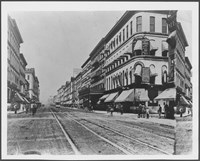- Lesson Plan (5)
- Field Trips (4)
- Distance Learning (1)
- Teacher Reference Materials (1)
- Social Studies (11)
- Literacy and Language Arts (3)
- Math (2)
- Science (1)
Showing 11 results for Surrender ...
Perspectives After the Surrender at Appomattox CH
- Type: Lesson Plan
- Grade Levels: Middle School: Sixth Grade through Eighth Grade
This program will allow students to think about the different perspectives of those who lived through the Civil War, and how various viewpoints interpreted the events surrounding the Surrender Meeting at Appomattox. This program consists of several assignments designed to help students explore these differences through the stories of three people present at Appomattox Court House in 1865.
After Appomattox: Artifacts of Slavery and Freedom
- Type: Distance Learning
- Grade Levels: Upper Elementary: Third Grade through Fifth Grade
Escape the Battlefield, Win the War!
- Type: Lesson Plan
- Grade Levels: High School: Ninth Grade through Twelfth Grade
The Southern Campaign of the American Revolution was the catalyst for the eventual surrender of General Cornwallis and the British at Yorktown, Virginia. Students will be given an escape room mystery to solve related to certain battles of the Southern Campaign. They will have 60 minutes to solve the given mystery and get out of the escape room.
The French and Indian War 1754-1763: How Did the Conflict Begin? - Unit 3
- Type: Lesson Plan
- Grade Levels: Upper Elementary: Third Grade through Fifth Grade

This unit teaches the students how the French and Indian War began. The students learn about George Washington’s 1753 trip to Fort LeBoeuf, read about George Washington in the French and Indian War, analyze the Fort Necessity surrender document and learn how Benjamin Franklin participated in the war. The lesson includes background information and four student activities
Segregation Laws in the 1800s: Williams v. Bellefontaine
- Type: Field Trips
- Grade Levels: Upper Elementary: Third Grade through Fifth Grade

In 1867, Neptune and Caroline Williams sued the Bellefontaine Railway Company over its discriminatory policies regarding African Americans. In a dispute with the streetcar operator, Mrs. Williams was hurt. The Williamses sued at the St. Louis Courthouse and won their case, but with a twist. Will students reach the same verdict?
Trial for the Right to Vote: Virginia Minor v. Happersett
- Type: Field Trips
- Grade Levels: Upper Elementary: Third Grade through Fifth Grade

In a room on the second floor of the St. Louis Courthouse in 1873, Virginia Louisa Minor sued a city registrar for denying her the right the register to vote. What was her argument? In this mock trial, students will reenact the 1873 trial, listen to both sides, and reach their own verdict in the case.
Appomattox Court House - Teacher Packet for Grades 4 through 11
Tort Liability: Franke v. City of St. Louis
- Type: Field Trips
- Grade Levels: Upper Elementary: Third Grade through Fifth Grade

Frederick Franke was injured in St. Louis when part of a building fell on his head as he was walking. Tragically, he died as a result of his injuries. His mother, Julia Franke, sued the owner of the building and the City of St. Louis for damages. This case was heard in 1888 in the St. Louis Courthouse (the Old Courthouse). Students will reenact the case and hear from all sides.
Freedom Suit: Dred Scott v. Irene Emerson
- Type: Field Trips
- Grade Levels: Upper Elementary: Third Grade through Fifth Grade

1846, an enslaved couple named Dred and Harriet Scott sued for their freedom at the St. Louis Courthouse, a historic courthouse managed by the National Park Service at Gateway Arch National Park and referred to as the "Old Courthouse." In this mock trial, students learn about the second trial the Scotts undertook at the courthouse in 1850. During this case, the court declared Dred Scott to be a free man. How will students interpret the case?
Flags and National Identity
- Type: Lesson Plan
- Grade Levels: Upper Elementary: Third Grade through Fifth Grade
The records Lewis Garrard kept during his ten-month journey along the Santa Fe Trail provide an outsider's view into intercultural interactions in the 1840s. This lesson features how national identity and sovereignty have been communicated through dress, color, and symbols in early American history as well as today.
- Type: Lesson Plan
- Grade Levels: Middle School: Sixth Grade through Eighth Grade
Students will research information to find information about the number of wounded from both patriot and British forces from the SC revolutionary battles: Battle of Camden, Battle of Waxhaws, Kings Mountain, and Cowpens. They will then create a graph that compares the number both injured and fatally wounded.


